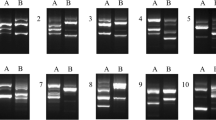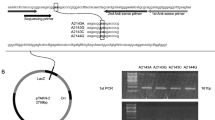Abstract
The aim of the study was to determine inter- andintrapatient variation of Helicobacter pylori strainsbased on genomic fingerprinting and cagA(cytotoxin-associated gene A) status. Ten bacterialcolonies from each of 10 patients with gastric cancer(GC), 10 with duodenal ulcer (DU), and 10 with gastritis(GI) were used. The presence of the putative adhesingene, the cagA gene, and the strain specific banding pattern obtained by arbitrary primed (AP-) PCRwas analyzed. Genomic fingerprinting showed extensiveinterpatient variation, but the banding patternsobtained from colonies from the same patient were always identical (intrapatient variation). In fivepatients, the cagA status varied between the coloniesdespite identical banding patterns. Among patients in adeveloped country such as Sweden, the proportion with multiple-strain infection of H. pylori islow, but subclones with differing cagA status existwithin the strain.
Similar content being viewed by others
REFERENCES
Clayton CL, Kleanthous H, Morgan DD, Puckey L, Tabaqchali S: Rapid fingerprinting of Helicobacter pylori by polymerase chain reaction and restriction fragment length polymorphism analysis. J Clin Microbiol 31:1420-1425, 1993
Taylor NS, Fox JG, Akopyants NS, Berg DE, Thompson N, Shames B, Yan L, Fontham E, Janney F, Hunt FM, Correa P: Long-term colonization with single and multiple strains of Helicobacter pylori assessed by DNA fingerprinting. J Clin Microbiol 33:918-923, 1995
Fujimoto S, Marshall B, Blaser MJ: PCR-based restriction fragment length polymorphism typing of Helicobacter pylori. J Clin Microbiol 32:33-334, 1994
Salama SM, Jiang Q, Chang N, Sherbaniuk RW, Taylor DE: Characterization of chromosomal DNA profi les from Helicobacter pylori strains isolated from sequential gastric biopsy specimens. J Clin Microbiol 33:2496-2497, 1995
Taylor DE, Eaton M, Chang N, Salama SM: Construction of a Helicobacter pylori genome map and demonstration of diversity at the genome level. J Bacteriol 174:6800-6806, 1992
Burucoa C, Lhomme V, Fauchère JL: Combination of DNA fingerprinting methods is needed for analysis of genetic diversity among unrelated and familial Helicobacter pylori isolates. Gut 2(suppl):A66 (abstract 3B:64), 1996
van der Ende A, Rauws EAJ, Feller M, Mulder CJJ, Tytgat GNJ, Dankert J: Heterogenous Helicobacter pylori isolates from members of a family with a history of peptic ulcer disease. Gastroenterology 111:638-647, 1996
Fantry GT, Zheng Q-X, Darwin PE, Rosenstein AH, James SP: Mixed infection with cagA-positive and cagA-negative strains of Helicobacter pylori. Helicobacter 1:98-106, 1996
Jorgensen M, Daskalopoulos G, Warburton V, Mitchell HM, Hazell SL: Multiple strain colonization and metronidazole resistance in Helicobacter pylori-infected patients: identification from sequential and multiple biopsy specimens. J Infect Dis 174:63-635, 1996
Miehlke S, Small SM, Gutierrez O, Thomas R, Graham DY, Go MF: Coinfection with multiple strains of H. pylori is uncommon even in developing countries: evidence by DNA fingerprinting of single colonies. Gut 2(suppl):A87 (abstract 4B:30), 1996
Ghoneim TA, Crabtree JE, Ghoneim AT: Molecular finger-printing of pre and post treatment isolates of H. pylori using the random amplified polymorphic DNA (RAPD) technique. Gut 2(suppl):A81 (abstract 4B:03), 1996
Blaser MJ: Not all Helicobacter pylori strains are created equal: Should all be eliminated? Lancet 349:1020-1022, 1997
Censini S, Lang C, Crabtree JE, Ghiara P, Borodovsky M, Rappuoli R, Covacci A: cag, a pathogenicity island of Helicobacter pylori, encodes type I-specific and disease-associated virulence factors. Proc Natl Acad Sci USA 93:14648-14653, 1996
Hacker J, Blum-Oehler G, Mühldorfer I, Tschäpe H: Pathogenicity islands of virulent bacteria: Structure, function and impact on microbial evolution. Mol Microbiol 23:1089-1097, 1997
Evans DG, Karjalainen TK, Evans DJ Jr, Graham DY, Lee CH: Cloning, nucleotide sequence, and expression of a gene encoding an adhesin subunit protein of Helicobacter pylori. J Bacteriol 175:674-683, 1993
Tummuru MKR, Cover TL, Blaser MJ: Cloning and expre ssion of a high-molecular-mass major antigen of Helicobacter pylori: Evidence of linkage to cytotoxin production. Infect Immun 61:1799-1809, 1993
Leying H, Suerbaum S, Geis G, Haas R: Cloning and characterisation of a Helicobacter pylori flagellin gene. Mol Microbiol 6:2863-2874, 1996
Forbes KJ, Fang Z, Pennington TH: Allelic variation in the Helicobacter pylori flagellin genes flaA and flaB: Its consequences for strain typing schemes and population structure. Epidemiol Infect 114:257-266, 1995
Huratado A, Owen RJ, Desai M: Flagellin gene profiling of Helicobacter pylori infecting symptomatic and asymptomatic individuals. Res Microbiol 145:585-594, 1994
Held M, Nyrén O, Hansson LE, Wadström T, Adami HO, Engstrand L: Antibodies in gastric cancer patients to the cytotoxin associated antigene, Cag A. Gut 2( suppl):A16 (abstract 2A:06), 1996
Ilvar D, Arnqvist A, Ögren J, Frick I-M, Kersulyte D, Incecik ET, Berg DE, Covacci A, Engstrand L, Borén T: Helicobacter pylori adhesin binding fucosylated histo-blood group antigens revealed by retagging. Science 279:373-377, 1998
Jiang Q, Hiratsuka K, Taylor DE: Variability of gene order in different Helicobacter pylori strains contributes to genome diversity. Mol Microbiol 20:833-842, 1996
Akopyants NS, Kersulyte D, Berg DE: Specific DNA inversion in the genome of Helicobacter pylori. ASM General meeting, Miami Beach, Florida, May 4-8, 1997, Abstract B-64
Hazell SL, Andrews RH, Mitchell HM: Helicobacter pylori: Not a single species? Gut 2(suppl):A74 (abstract 3B:101), 1996
Blaser MJ: The versatility of Helicobacter pylori in the adaptation to the human stomach. J Physiol Pharmacol 48:307-314, 1997
Blaser MJ: Heterogeneity of Helicobacter pylori. Eur J Gastroenterol Hepatol 9(suppl 1):S3-S7, 1997
Covacci A, Falkow S, Berg DE, Rappuoli R: Did the inheritance of a pathogenicity island modify the virulence of Helicobacter pylori? Trends Microbiol 5:205-208, 1997
Rights and permissions
About this article
Cite this article
Enroth, H., Nyren, O. & Engstrand, L. One Stomach-One Strain (Does Helicobacter pylori Strain Variation Influence Disease Outcome?). Dig Dis Sci 44, 102–107 (1999). https://doi.org/10.1023/A:1026658301825
Issue Date:
DOI: https://doi.org/10.1023/A:1026658301825




